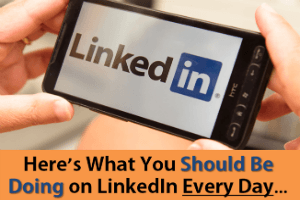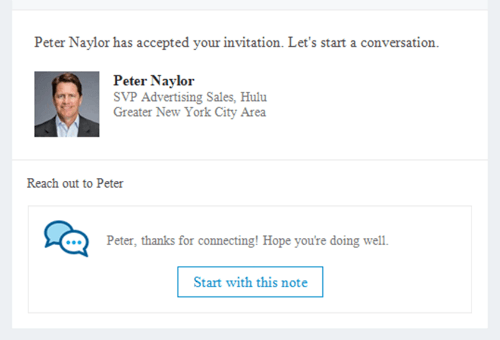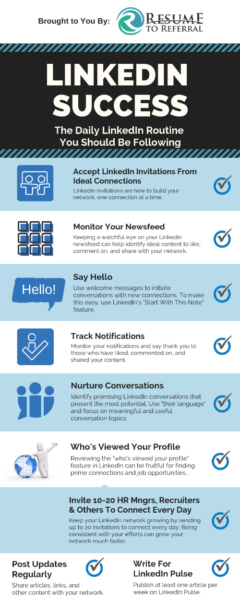LinkedIn routine? To some of us, a routine is boring.
But, to others, a routine is key to better prospecting, more efficiency, and peak performance.

Therefore, it makes sense that following a LinkedIn routine can be transformative to building a solid job-search network and effectively seeking new employment.
And, LinkedIn is the perfect place to source connections with current/former colleagues, HR managers, recruiters, and so on.
With this said, let’s take a look at the 9 tasks that should be part of your daily LinkedIn routine.
Invitations
________ Consider and accept LinkedIn invitations from ideal connections.
LinkedIn invitations are how to build your network one connection at a time.
Too many of us ignore or delete invitations because we’re not sure how to best handle them.
For example, should you connect with everyone?
In the beginning, you may want to as a means to build your network quickly. A relaxed acceptance policy also improves your chances of getting your LinkedIn profile seen by more people. This is important, especially during an active job search.
But, as your network builds, you may want to focus more on a quality approach. Being more selective with whom you connect with reduces your chances of receiving spam from new connections who don’t follow proper LinkedIn etiquette.
Newsfeed
________ Scan your LinkedIn newsfeed in search of content that you can like, comment on, and share.
Your LinkedIn newsfeed can be found by logging into your profile and selecting HOME from the top navigation.
Updates reflected in your newsfeed can be sorted by “recent” or “top” (most popular). You may wish to sort your newsfeed to reflect top posts, so you can pass on topics that are already sparking likes and comments.
Being an active LinkedIn member can go a long way to getting your LinkedIn profile seen more.
Use Welcome Messages
________ Send welcome messages to new connections to help initiate and massage future conversations.
LinkedIn makes welcome messaging easy by sending you emails showing those who’ve accepted your invitations to connect.
And, they offer you sample content (see the below): “Peter, thanks for connecting! Hope you’re doing well.”
Also notice how LinkedIn encourages me to reach out to Peter with one click on the box titled, “Start with this note.”

Track Notifications
________ Monitor your notifications to identify who has liked, commented on, and shared your content.
It’s important that you take the time to thank and respond to those who have interacted with your content — or, with others’ content that you’ve shared.
This seems very straightforward.
Yet, don’t overlook the networking opportunities you can find in notifications as well.
Be on the lookout for:
- Potential Employers & Referral Sources
- Possible Vendors/Suppliers For Your Current Employer
- Solutions That Can Boost Career Achievements
- Industry Changes
- Professionals to Opinions/Ask Advice From
Nurture Conversations
________ Identify promising LinkedIn conversations that present the most potential.
No doubt, this can be a time-consuming task.
In order to engage 1st-degree connections, it’s important to start with meaningful and useful topics.
This can be the most problematic for many of us.
What does meaningful and useful mean?
Begin by knowing your connections.
Learn to spot certain queues; e.g. maybe you’ve attended the same school or lived in the same city?
Ask questions and opinions from your connections (I find this to be the most optimal approach for starting conversations). People generally love sharing their knowledge and expertise with others.
Informational interviewing can be performed via LinkedIn, as these are nothing more than information-gathering sessions. These types of interviews can be used to learn more about hiring companies and ask “what” questions. For example:
- Ask for an introduction to a 2nd/3rd connection
- Give a compliment
- Identify psychographic or demographic details you have in common
- Inquire about attendance to an upcoming event
Who’s Viewed Your Profile
________ Reviewing the “who’s viewed your profile” feature in LinkedIn can be fruitful for finding clients.
LinkedIn enables you to see who’s viewed your profile in the past 90 days.
The purpose of scanning this report is to identify professionals to connect with.
For example, let’s say an HR Manager or Recruiter viewed your profile. Yet, he didn’t send a connection request, call, email, or send you a smoke signal. No communication whatsoever.
Invite 10-20 Professionals To Connect Every Day
________ Keep your LinkedIn network growing by sending up to 20 invitations to connect every day.
This might seem excessive at first.
Yet, LinkedIn is about making connections.
LinkedIn gives you a lifetime limit of invitations, which you shouldn’t let deter you. You can contact LinkedIn Customer Support to request more.
Although, there are some other workarounds such as:
First, withdraw pending invitations you’ve sent. Unfortunately, this is a manual process, which can get tedious. Yet, well worth the effort.
Second, you can ask professionals to invite you. This way, they are using up their invitation lifetime limit.
If that doesn’t work, remove less-value connections to make room for more ideal ones.
Post Updates Regularly
________ Be sure to share articles, links, and other content regularly with your network.
Some LinkedIn experts believe that you should publish several updates per day. Ted Prodromou, author of Ultimate Guide to LinkedIn For Business recommends publishing updates 4 times per day.
Sources such as Buffer believe that fewer is better.
You’ll need to decide what’s best for you/your network.
Beyond quantity, there’s something to be said about timing.
Studies have shown that there are best and worst times for posting on LinkedIn as well.
For example, TheBalanceSMB.com reported that most clicks occur on Tuesdays between 11:00 am and 12:00 pm.
The study also showed that Fridays and Mondays are not ideal for making connections and attracting likes and shares.
It’s speculated that this may be because Mondays are generally hectic and Fridays are used for making weekend plans and less about performing likes and shares.
Write For LinkedIn Pulse
________ Publish at least one article per week on LinkedIn Pulse.
True, not all career fields lend themselves for publishing content. For example, an Accounts Payable Clerk would have a short-lived writing career talking only about accounts payable. However, there are some career fields where writing to LinkedIn Pulse is ideal. For example:
Easy enough, right?
If you’re seeking more exposure for your LinkedIn profile, get into the habit of working on the above 9 tasks each day until it becomes routine. You can download the above list of habits by clicking the below:
